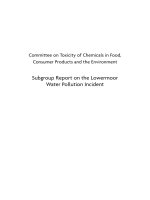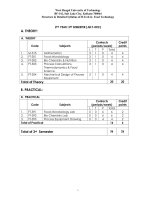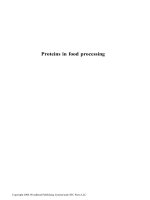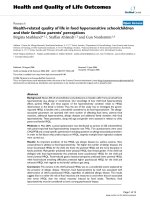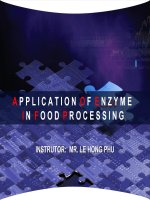Appication Of Enzyme In Food Processing pps
Bạn đang xem bản rút gọn của tài liệu. Xem và tải ngay bản đầy đủ của tài liệu tại đây (2.67 MB, 36 trang )
LOGO
A P P L I C A T I O N O F E N Z Y M E
I N F O O D P R O C E S S I N G
INSTRUTOR: MR. LE HONG PHU
INSTRUTOR: MR. LE HONG PHU
LOGO
Click to edit Master text styles
Group members
NGUYEN THI THAO LINH BT070047
1
NGUYEN DO THIEN HUONG BT070024
2
PHAM NGUYEN HUONG THU BT070156
3
HUYEN TON NU QUYNH HUONG BT070023
4
NGUYEN PHUONG LOAN BT070050
6
DINH NGUYEN GIA AN BT070002
5
Introduction
How to use enzyme in food processing
Application of enzyme in food processing
Content
Enzyme in food processing
The advantages of using
Enzyme in Food Processing
They are an essential part of our current methods for making cheese,
yogurt, beer and wine.
Enzymes can be used to :
Alter the appearance, aroma, texture and flavor of a product.
Deliver nutrients more effectively to the body or to make a food that is
difficult to digest a bit easier to swallow.
Accelerate the good fermentation time, giving a finished product in weeks
instead of months.
Have long been used in food processing.
Advantages of Enzyme
They are welcomed as alternatives to traditional chemical -based
technology, and can replace synthetic chemicals in many processes.
Processes which use enzymes therefore have fewer side reactions
and waste by-products, giving higher quality products and reducing the
likelihood of pollution.
They allow some processes to be carried out which would otherwise
be impossible.
APPLICATION OF ENZYME IN FOOD PROCESSING
Step 1 Decide what you would like your enzyme to do.
Enzymes function in unique and predetermined ways.
Step 2 Determine the probable target market for the product.
Step 3 Research the physical components of the product (production materials
and methods) to find the most efficient enzyme match.
Step 4 Decide which enzyme would work best for your product.
.
Step 5 Make sure that you understand very clearly and deeply about the activities
of the enzyme
Step 6 Establish a method so that the enzyme can act efficiently without
undesirable degradation of food components (such as freezing or
refrigeration) and ascertain the shelf life of the finished product.
Step 7 Find a source for your enzyme and produce a test batch of your product to
determine if the enzyme functions as you hoped it would.
HOW TO USE ENZYMES IN FOOD PROCESSING
Objective:
Remove the remainder of the
fruit pulp.
Remove the mucilage which
surrounds the coffee bean.
Remove the coat of coffee bean.
Mechanism:
breaking down cellulose, pectin and protopectin (the main
components in coffee pulp and the mucilage)
The enzyme used:
cellulase (endocellulase and extracellulase, β-glucosidase)
pectinase
protopectinase
The source of enzymes:
Produced by the fungi named Aspergillus Niger
***Notation: The fermentation process has to be carefully monitored to ensure that
the coffee doesn't acquire undesirable, sour flavours.
Purify the coffee bean from the
undesirable substances
Save the time.
Improve the coffee flavor.
Improve the quality and safety of the
product
LOGO
ENZYMES IN BAKING
Benefits of using enzymes in baking
Change Improvement Enzymes used
Processabilities Shorter fixing/proofing time,
better dough stability
Proteases, xylanases,
oxidases, lipases
Texture Softer crumb, fine and regular
pore structure, better crispness
α- Amylases, proteases,
xylanases
Volume Large volume, high-fibre baking
α- Amylases, xylanases, β-
glucanases
Stability Anti-staling effects, extended
shelf-life, improve freshness
α- Amylases, xylanases
Nutritional properties Increased amount of total and
soluble dietary fibre and reduced
fat baking
α- Amylases, β-glucanases,
cellulases
Flavor Production of fermentation
substrate and aroma precursors
α- Amylases, proteases,
lipoxylanases, lipase, glucose
oxidase
Color Browning effects, improve crush
color, bleaching effects
α- Amylases, glucoamylases,
lipoxygenases
LOGO
17
Cheese is a food consisting of
proteins and fat from milk,
usually the milk of cows, buffalo,
goats, or sheep.
It is produced by coagulation of
the milk protein casein
PRODUCTIVE PROCESSING
18
FRESH MILK
Standardizationù
Meat infusion
Pasteurisation
Freeze
Fermentation
Products
Mix
Split milk serum
Lactic
bacterium
Cream Adjuvant
packing
Milk serum
CHEESES
CHEESES
07/02/200719 Viadeo PowerPoint template
Rennin & Rennet are enzymes use to coagulate milk
Proteases : use to creamier the cheese products
Lactase : use to make cheese more creamier and
sweeter-tasting
Catalase : is used to preserve natural milk enzymes that
are beneficial to the end product and flavour development of
the cheese
Lipases : Lipases are used to break down milk fats and
give characteristic flavours to cheeses
LOGO
Filtering of the content: Fish sauce
“Fermentation” for at least 6 months
Tanks are filled (completely) and sealed
Transfer to fermentation tanks, temp 40°C
Fish and salt is mixed in a ratio of 1:3
Participation of enzymes in the hydrolysis
mechanism catalyzed
Phase 1(0-25 days): There is an increase volume of the liquid floating
on the surface of products and soluble protein.
Phase 2( 80-120 days): cellular tissue is broken. proteins of the cell
become exposed to the enzyme, the product of the process of self-
protein is released
Phase 3( 140-200 days): Enzyme released and attack on the soluble
protein. These changes cause nitrogen compounds.
www.designfreebies.org
ENZYME SYSTEMS IN THE PRODUCTION OF
FISH SAUCE
METALO-PROTEASE
PROTEASE
SERIN-PROTEASE
(TRIPSIN ENZYME)
ACID- PROTEASE
( CATHEPSIN D)
HYDROLYZED
THE
PEPTIDE
BOND
Fish’s
viscus
Exist
LOGO
SOME FACTORS AFFECT THE ENZYMES
Temperature ( 30-47oC)
If temperature increase loss the activity of enzymes hydrolysis
process less
pH
Select the appropriate pH to facilitate the enzyme works best ( pH at
5.5-6.5). This pH effect inhibits a bacteria rot.
Surface area
increase the area of contact between enzyme and fish speed up
the hydrolysis of many peptide
Salt
Salt for about 20-25% of the volume of fish to inhibit the growth of
bacteria that cause rot
LOGO

